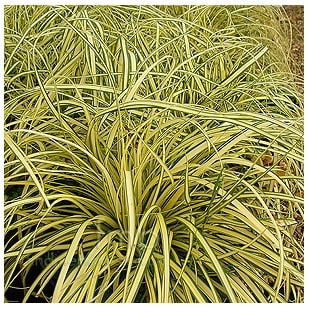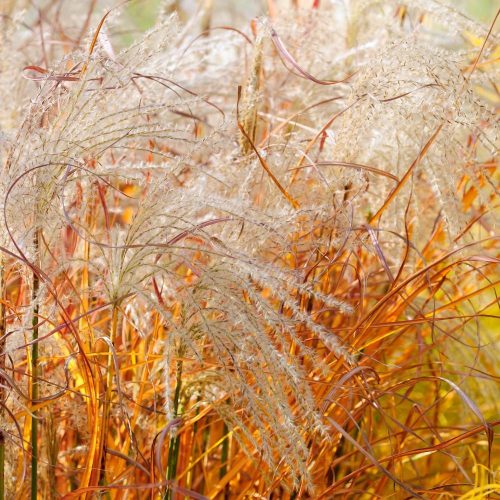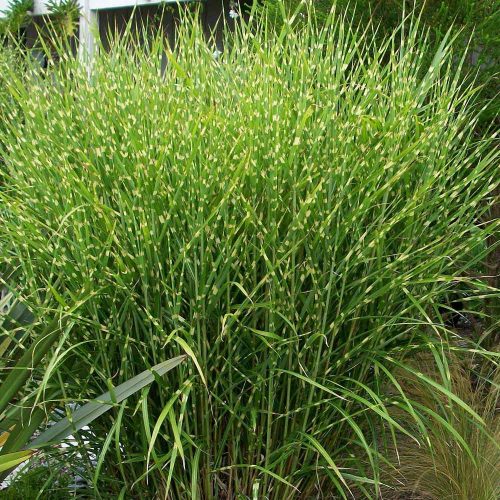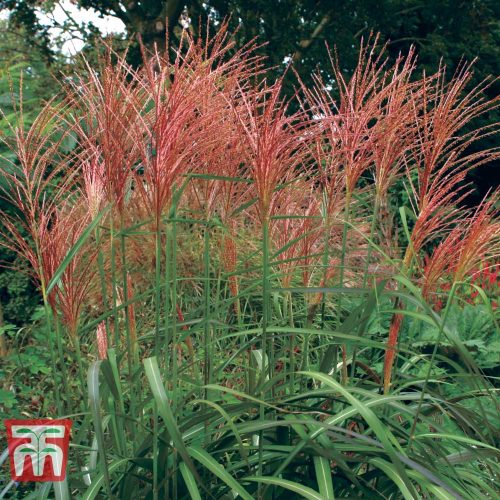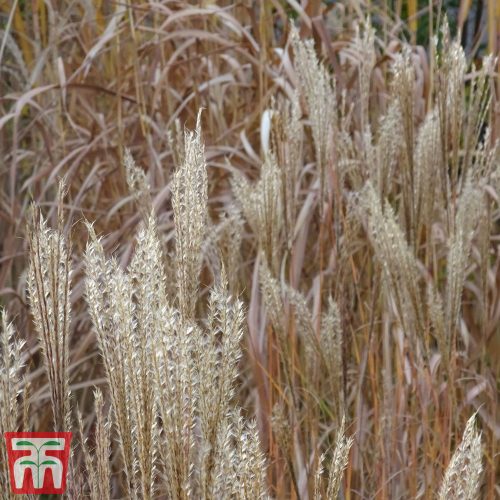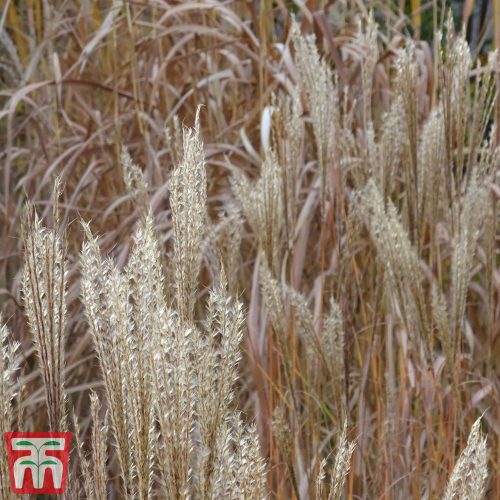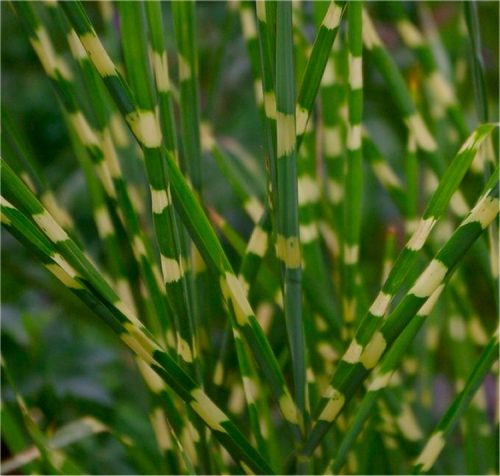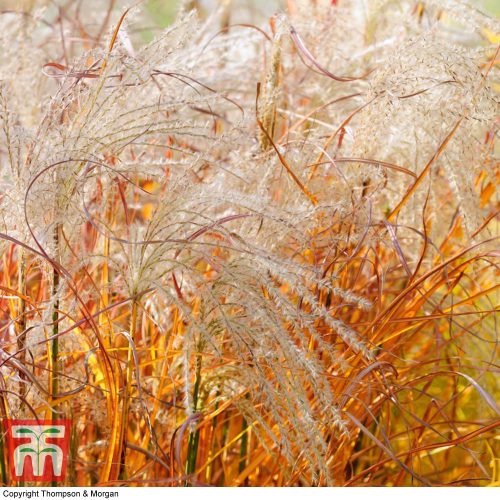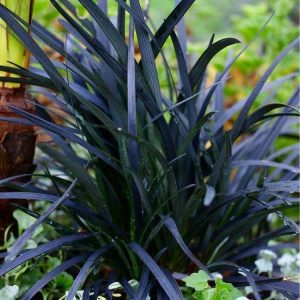 Ornamental Grasses – Exotic & Tropical Grasses
Ornamental Grasses – Exotic & Tropical Grasses
Arundo donax Variegata Compact
Grasses are not normally associated with exotic gardens, which is a shame because they add movement and verticality ad are a good substitute for plants we can’t grow in our more temperate climate. Whether short or exceedingly tall, grasses give height, stature, and form, many with a very architectural appearance, with the added attraction that the foliage catches the wind, adding motion to the landscape. If space is limited, use some of the smaller species and cultivars, which look especially good weeping over the sides of pots and containers. I have also included a few other plants here that have similar spiky or grassy feel to them. I love to grow Miscanthus here in the UK!
Ornamental Grasses
Ornamental grasses are an important part of gardens used to create structure. They come in varying sizes as tall ornamental grasses, short ornamental grasses, low-growing ornamental grasses or high ornamental grasses.
Also, they create an attraction with beautiful foliage that catches the wind and creates ornamental shade in the landscape. They are classified into cool-season ornamental grasses, warm-season ornamental grasses, and evergreen ornamental grasses.
Additionally, the planting methods and care differ depending on the type of ornamental grasses and their location. For instance, ornamental grasses in the UK will have a different care procedure from ornamental grasses in other temperate regions.
Types Of Ornamental Grasses
Arundo Donax
This is a clump-forming, rhizomatous, perennial, evergreen ornamental grass. It can be found growing in boggy areas like lakes, riverbeds, streams, and beside ponds. Sometimes regarded as an invasive plant because its bamboo-like foliage and stems are quick to spread and can take over your garden if not checked. It is relatively easy to maintain as long as it is grown in moist soil with full exposure to sunlight. Lastly, for the best foliage, cut back the growth annually to give room for new foliage to develop.
Carex Ornamental Grasses
This genus of ornamental grasses contains over 1500 species of evergreen ornamental perennials. They are found growing in diverse habitats in different regions and climates. They are cultivated for their shapes, sizes, and sometimes variegated foliage. These versatile perennials are extremely hardy with some species being hardier than others. They are best grown in a gravel garden or groups around shady corners.
Where to buy ornamental grasses in the UK?
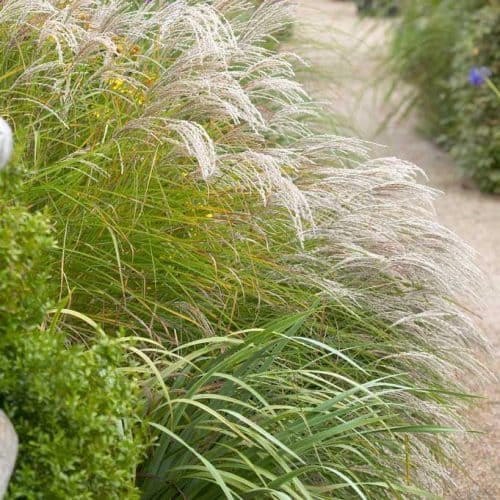 Miscanthus sinensis Kleine Fontaine Feathery red flower-plumes maturing to silver-white held above clumps of slender arching mid-green leaves from late summer and late autumn. This medium-sized ornamental grass has a long flowering season and good autumn colour. A perfect specimen plant for a sunny site the stiff stems and flower heads are a feature of the winter garden.
Miscanthus sinensis Kleine Fontaine Feathery red flower-plumes maturing to silver-white held above clumps of slender arching mid-green leaves from late summer and late autumn. This medium-sized ornamental grass has a long flowering season and good autumn colour. A perfect specimen plant for a sunny site the stiff stems and flower heads are a feature of the winter garden. Miscanthus sinensis ‘Morning Light’ or Japanese Silver Grass. Miscanthus can be deciduous or evergreen, depending on the severity of the winter. This popular grass grows to about 1m x 50cm wide. It has a tufted, spreading habit with erect stems with arching, linear leaves finely edged with white, thus giving the whole plant a delightful silvery appearance. From late summer and through the winter month’s terminal pinkish -bronze tinged panicles appear that mature to a fluffy cream colour. This ornamental grass prefers full sun and moist fertile soil, and once established, it will tolerate drought conditions as well as taking wind and snow in its stride. The foliage should be left standing throughout the winter months as it looks good and also provides protection for the crowns. The old stems should then be cut to the ground in late winter to early spring, when it will quickly regenerate into a new mound of fresh growth. Common Name: Japanese Silver Grass Latin name: Miscanthus sinensis ‘Morning Light’ Tenderness Rating: Hardy down to -15C Ease of growing: Easy Position: Prefers full sun to dappled shade Soil Condition: Moist, fertile, well-drained soil
Miscanthus sinensis ‘Morning Light’ or Japanese Silver Grass. Miscanthus can be deciduous or evergreen, depending on the severity of the winter. This popular grass grows to about 1m x 50cm wide. It has a tufted, spreading habit with erect stems with arching, linear leaves finely edged with white, thus giving the whole plant a delightful silvery appearance. From late summer and through the winter month’s terminal pinkish -bronze tinged panicles appear that mature to a fluffy cream colour. This ornamental grass prefers full sun and moist fertile soil, and once established, it will tolerate drought conditions as well as taking wind and snow in its stride. The foliage should be left standing throughout the winter months as it looks good and also provides protection for the crowns. The old stems should then be cut to the ground in late winter to early spring, when it will quickly regenerate into a new mound of fresh growth. Common Name: Japanese Silver Grass Latin name: Miscanthus sinensis ‘Morning Light’ Tenderness Rating: Hardy down to -15C Ease of growing: Easy Position: Prefers full sun to dappled shade Soil Condition: Moist, fertile, well-drained soil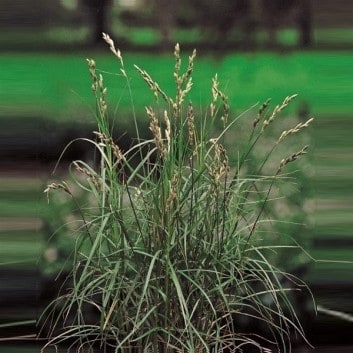
Carex Muskingumensis
Carex Muskingumensis, named after the Muskingum river in Ohio and commonly called palm sedge is a semi-evergreen, clump-forming sedge native to western regions of North America. It is grown for its boastful tapering bright green foliage grass-like leaves that are about 8 inches long and somewhat resemble the leaflets of a palm frond. The leaves radiate from the top of rigid stems about 20 inches in length. Often grown as an ornamental grass These beautiful leaves change colours with the season. In spring when they’re growing, they are golden brown and hold this colour through the summer season, before turning to copper colour in autumn and finally going dormant in winter. Late in the spring, they produce inconspicuous flower spikes between the foliage that lasts through the summer. Oftentimes, they are found in wooded flood plains, wooded swamps, and hence is a great choice for water gardens, wetland, gardens, or used as a ground cover. Lastly, they serve as a food source for several species of birds.Description of Carex Muskingumensis
They are called sedges because the leaves and stems have sharp edges. They are slow-growing plants that will spread by rhizomes and self-feeding to about 2 to 3 feet tall and 60 to 90 cm wide.How To Grow And Care For Carex Muskingumensis
Carex Muskingumensis is a low-maintenance plant that is easy to grow. Propagation can be done by seed, cuttings, or division of clumps.Propagating and growing Carex Muskingumensis from seed
To begin propagating Carex Muskingumensis from seed, clear the planting site from weeds and other shrubs that might compete for soil nutrients. Next, plant the seeds just below the surface of moist soil, but not wet. The temperature around the planting side should be about 20 degrees celsius but after germination, it should be moved to a cooler environment. Sowing of seeds should be done early in spring or late in autumn and germination will occur after 6 to 10 weeks.Carex Muskingumensis Propagation by cuttings
Cuttings should be taken in autumn.Requirements for Carex Muskingumensis
- Soil: This plant thrives in moist to wet organically rich soil. Soil types like chalk, sand, clay or loamy soil are ideal. Alternatively, it can also be grown in shallow water. The solid should also be well-draining and can be acid, alkaline, or neutral.
- Light: It is best when grown in full sun. 6 to 8 hours of daily sunlight exposure is great and it can as well tolerate partial shade. West-facing, south-facing, or east-facing is an ideal position.
- Water: It needs a lot of water to grow successfully. The topsoil should be kept consistently moist to soggy and should not be allowed to dry in between watering periods.
- Pruning: It does not require any form of pruning but to protect it from harsh winds and frost you should cut it to the ground during winter. Don’t worry, your plant will grow out new and fresh in the next growing season.
- Insects and diseases: because of its flowers, butterflies, moths, songbirds, and other pollinators are attracted to it. It is deer resistant and other harmful insects and plant diseases are rare with this species.
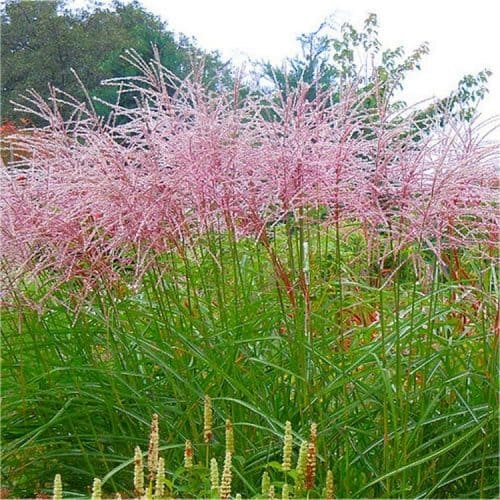
Miscanthus Sinensis ‘Flamingo’
Miscanthus Sinensis ‘Flamingo’, commonly referred to as Chinese silver grass, silver grass flamingo, Eulalia grass, Eulalia flamingo, maiden grass, zebra grass, Susuki grass, or porcupine grass is a flowering plant native to Asia. It is a widely cultivated variety especially in temperate regions of the world and is valued for a beautiful ornamental grass. Miscanthus Sinensis ‘Flamingo’ is a grassy plant that has narrow, arching, mid to dark green leaves and red-flushed stems in late summer and early autumn, with white prominent midribs that turn orange-gold shades in the fall; and slightly pendant, feathery flower plumes which bloom in late summer. It flowers earlier than many Miscanthus varieties. At first, each plume is pink-tinged then later delicately changes to a silvery-white colour as it ages-rising well above the elegant foliage. This perennial plant with elegant foliage grows in the wetlands, is deciduous, floriferous, and has a clump-forming habit; capable of spreading 3 tom4 feet in width and growing to a height of 5 to 6 feet in about 2 to 5 years.Miscanthus Propagation Methods
Chinese silver grass is best propagated by division and seed, having the plant dug up and divided or sowing the seeds in a cold frame in early spring.Growing Conditions for Miscanthus
Miscanthus species are generally hardy and can be planted in autumn, although the best time to plant them is in late spring. They can be slow in establishing their roots but are fast-growing and considered versatile, low-maintenance plants of great winter interest. Also, they have invasive tendencies (especially in the US) and require space, although this attribute is dormant in the UK. However, a best gardening practice is to not plant more than one cultivar in the same space.- Soil: Miscanthus flamingo tolerates most soils and can be planted in any moderately fertile, moist, and well-draining with a pH range of 5 to 7.5. They will do well in chalky, clay, loamy, or sandy soil of acidic, alkaline or neutral nature.
- Light: Miscanthus flamingos can be planted in full sun to light or partial shade, although they perform best in full sun in terms of growth, width, and movement. They flower best after a hot sunny period and hence, planting them in deep shade is not advised.
- Water: Miscanthus flamingo plants should be well-watered but not over-watered in the first year after planting until their roots get established. They are drought-tolerant and hence require only occasional watering; watering isn’t required in the presence of sufficient rainfall. They should be protected from winter wetness as that could cause their roots to rot and other diseases might emerge from that.
- Temperature: Miscanthus flamingo plants are very receptive to warm temperatures from early to mid-summer, as they aid in their growth. They are also full frost-hardy, capable of withstanding temperatures of up to -29 to 5 degrees Fahrenheit.
- Pruning: Miscanthus flamingo plants look good all year round, but might need to be cut back in spring. It is recommended to tie up the leaves and remove dead foliage and old flowered stems, cutting them to the ground in late winter to early spring before new shoots appear-encouraging new growth again.
- Fertiliser: Miscanthus flamingo plants thrive well on their own and do not require feeding from fertilizer. However, the addition of mulched well-rotted manure or organic matter and grit to the soil is acceptable. Feeding, in any case, should occur only once every year, preferably in late winter or early spring as too much fertilizer can lead to the plant flopping.
- Insects and Diseases: Miscanthus flamingo plants are largely free of pests and diseases. They are deer and rabbit resistant but attractive to birds.
Where to buy Miscanthus flamingo in the UK?
 One of the best and most versatile evergreen grasses this will thrive in sun or shade and glows shades of copper gold and bronze-orange - hence the common name of Pheasant's Tail Grass. It has a soft arching habit so plant it among shrubs for textural contrast or in a mixed or herbaceous border. Supplied in approx 1.5-2 litre containers.
One of the best and most versatile evergreen grasses this will thrive in sun or shade and glows shades of copper gold and bronze-orange - hence the common name of Pheasant's Tail Grass. It has a soft arching habit so plant it among shrubs for textural contrast or in a mixed or herbaceous border. Supplied in approx 1.5-2 litre containers. A popular but hard to find variety of liriope valued for its relatively wide strappy green and creamy golden variegated grass-like foliage. This is a clumping selection which is outstanding in mixed container plantings or as an edging. From midsummer into late Autumn lilac purple flowers similar to grape hyacinths are produced. This plant will grow almost anywhere. It tolerates full sun partial shade or full shade and is somewhat drought tolerant. Supplied in approx 2-3 Litre containers.
A popular but hard to find variety of liriope valued for its relatively wide strappy green and creamy golden variegated grass-like foliage. This is a clumping selection which is outstanding in mixed container plantings or as an edging. From midsummer into late Autumn lilac purple flowers similar to grape hyacinths are produced. This plant will grow almost anywhere. It tolerates full sun partial shade or full shade and is somewhat drought tolerant. Supplied in approx 2-3 Litre containers. Carex oshimensis ‘Eversheen’ is a superb ground cover and container plant with distinctive lime yellow striped foliage. A wonderful little evergreen selection with a fresh appearance it is easy to grow low maintenance and forms a neat easily controlled mound. ‘Eversheen’ is a great cold hardy accent plant to provide all year round interest be it the cooler months or equally as contemporary value for the summer period. Ideal for adding a spot of interest to patio planters baskets and window boxes they can of course simply be planted out in the garden where they will grow to nicely sized plants for garden borders or gravel gardens. Try mixing with contrastingly coloured foliage plants such as Heuchera for extra interest is just one idea on how to utilise Eversheen grasses. Evergreen Carex are also excellent for mixing in with herbaceous perennials foliage plants and other flowers. providing year round colour and contrast they look lovely with virtually all other plants. Plant en-mass for a drift of dramtic groundcover. Slightly spreading in nature it will also look lovely cascading at the edge of a water feature or patio planter. For sun or part shade it is ideal in moist well-drained soils. Supplied in approx 2-3 litre containers.
Carex oshimensis ‘Eversheen’ is a superb ground cover and container plant with distinctive lime yellow striped foliage. A wonderful little evergreen selection with a fresh appearance it is easy to grow low maintenance and forms a neat easily controlled mound. ‘Eversheen’ is a great cold hardy accent plant to provide all year round interest be it the cooler months or equally as contemporary value for the summer period. Ideal for adding a spot of interest to patio planters baskets and window boxes they can of course simply be planted out in the garden where they will grow to nicely sized plants for garden borders or gravel gardens. Try mixing with contrastingly coloured foliage plants such as Heuchera for extra interest is just one idea on how to utilise Eversheen grasses. Evergreen Carex are also excellent for mixing in with herbaceous perennials foliage plants and other flowers. providing year round colour and contrast they look lovely with virtually all other plants. Plant en-mass for a drift of dramtic groundcover. Slightly spreading in nature it will also look lovely cascading at the edge of a water feature or patio planter. For sun or part shade it is ideal in moist well-drained soils. Supplied in approx 2-3 litre containers.
General Care For Ornamental Grasses
This section will address the most common concerns about cultivating ornamental grasses including when to plant them, when and how to cut them down, and how to divide ornamental grasses.
When to plant ornamental grasses
The best planting season for ornamental grasses is in spring to early fall because the summer heat and dry weather will give them enough time to establish a strong root network before the stressful winter season.
Planting in summer may create more stress in the care process because they have to be constantly watered to avoid dehydration and drying up in the summer heat. If you miss the planting window in spring then wait for the early autumn which is still about 6-8 weeks before the first signs of frost; that is ample time for the plant to develop.
When to cut back ornamental grasses
A great majority of plants including trees, shrubs, and grasses lose their colours in autumn as the weather becomes colder and most ornamental grasses are not different. Once your ornamental grasses that thrive in the warm season begin to turn brown then you know it is time to cut them back.
Cutting these browning grasses back will help you to keep your garden neat but if you don’t mind the brown colours in your garden then you can leave them through the winter since snow encrusted on the grasses makes a beautiful view. However, be sure to cut them down to a few inches above the ground to allow new growth to spring out in the next growing season.
How to cut down ornamental grasses
Begin by getting your equipment ready. All you need are pruning shears, a power hedge trimmer, and tapes or bungee cords.
Tie the grass into bundles: Cutting down ornamental grasses can get messy especially with the size of the ornament grass being cut down. To lessen the mess, put your gloves on and begin separating the stalks into bundles using the bungee cords or tapes to hold each bundle. Some stalks may need to be bundled separately depending on the size.
Cut the grass: After bundling the stalks of grasses you can begin cutting the stalks a few inches below the tapes with your pruning shears or a power hedge.
Clean up: The bulk of the work is the cutting and now that you’re done look around for some of the grass that escaped the trimming and go in with your pruning shears to level it out. Proceed to use a rake to clear up the stalks of grass left on the garden floor.
When to divide ornamental grasses
You can increase the number of plants in your care without spending a dime by dividing the grasses. Dividing ornamental grasses help the grasses to keep growing actively and renew older grasses. According to the classification of ornamental grasses; divide warm-season grasses in spring and mid-summer, divide cool-season grasses in spring and early fall, divide evergreen grasses in spring.
How to divide ornamental grasses
Simply use your hands, pruning shears, a spade or a shovel to separate some grasses from the sides of large clumps. Alternatively, you can dig up the entire plant, split it in half or quarters and proceed to replant.
FAQ
When do you cut back ornamental grasses?
You can cut back ornamental grasses at any time. Ideally, you should cut back your ornamental grasses when they start to turn brown in autumn or mid-late spring. Trim them till they are only a few inches high.
Are ornamental grasses evergreen?
A large percentage of ornamental grasses are not evergreen, rather they are deciduous plants that die back and begin changing colour in autumn before reviving for the next growing season in spring. However, some ornamental grasses are evergreen and remain green in winter.
Do ornamental grasses need to be cut back?
Cutting back your ornamental grasses is not mandatory, but you can cut them back when it begins to change colour in the fall to prepare them for the next season and can also be cut back for pruning purposes.
How do you divide ornamental grass?
The division of ornamental grasses is simple. Simply divide from the sides of large clumps with a spade or shovel. Alternatively, you can dig up the entire plant, split it in half or quarters and proceed to replant.
Can ornamental grasses be divided?
Yes, ornamental grasses can be divided for the sake of replanting or to reduce the size of a clump and prevent larger plants from losing their attraction.
How do you prune ornamental grasses in spring?
Pruning ornamental grasses is a simple task and all you need are pruning shears, a power hedge trimmer, and tapes or bungee cords. Use the tapes and bungee cords to tie the plants into bundles, and go in with the power hedge trimmer and cut off the grass from just below where the tape is holding the grass. Finish up with pruning shears for the loose hairs outside the bundle.
Should I cut back ornamental grasses?
It is not compulsory to cut back ornamental grasses but you can prune them when it starts to turn brown to prepare them for the next growing season.

